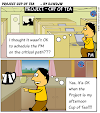Work out final and intermediate Products - a Product Breakdown Structure (PBS) may be useful
The first step is to work out what Products are to be produced / utilised by the Project. The final one(s) should be easier to define but then you need to think of intermediate ones - those which are needed to achieve the final Products.
A Product Breakdown Structure (PBS) may be useful to tool to help in the thinking process and ensure that you have identified all Products.
It shows the breakdown of the final Product with intermediate Products and a breakdown of these if appropriate but doesn't imply any order of production. Some tips are:
- the top of the structure is the Final Product
- show Products NOT Activities (look for nouns or outcomes in the past tense). So don't confuse with a Work Breakdown Structure (WBS) which is concerned with activities. For example, "trained workforce" is a valid Product, "training workforce" is not. This may seem semantic but it is quite important
- distinguish "External" Products which exist already (e.g. brought in, provided by another Project) versus "Internal" Products which need to be created by the Project
- Products under another Product go to make the higher Product
- Rectangle - Product produced by Project
- Eclipse - Product external to Project. So these become External Dependencies
- Rhomboid - not a Product but a collection of Products
So here is my list for a "Cup of Tea" (actually Mug because a cup isn't big enough)
- Mug of Tea - the final Product
- Consumables - Teabag, Cold Water, Milk (all Dependencies as I am assuming someone else has provided these) and Hot Water which is a Product produced by the Project
- Equipment - Mug, Spoon, Kettle (all Dependencies as I am assuming someone else has provided these)
In theory you should produce Product Descriptions (PD) for all these Products, but often I believe the information can be held elsewhere in your Plan as per my post on Product Descriptions
A Product Flow Diagram (PFD) is useful if the order of Use / Production isn't obvious
The Product Flow Diagram (PFD) shows the sequence of use / production of the various Products identified by the PBS. Here is the Mug of Tea example
 |
| Mug of Tea Product Flow Diagram (PFD) |
This Product Based Planning now assists in production of your Plan Schedule
Firstly, the product list and sequence is a useful way of assessing Project progress outside the schedule by answering two key questions:
- has the Product been produced?
- has the Produce successfully passed the Quality process defined for it?
I have even used this basic approach as a simplified approach to measuring Earned Value, a topic I wrote a presentation about a few years ago.
Secondly, this gives you the framework to produce 80% of your Plan Schedule:
- task(s) and resource(s) to produce the Product. Estimate effort to produce and thus duration
- task(s) and resource(s) to quality assure the Product. Estimate duration (and effort) to undertake the quality plan (see post on document quality planning but other Products need quality plans too)
- Some task dependencies implied by the PFD, others obvious (you can't quality assure a Product until it is produced!)
- Don't forget Management Products (to operate the Project) if your Product based Planning has focused on Technical Products
So here are 80% of your tasks and a framework to fit the remaining 20% of tasks such as Risk management actions, Communications etc. With a bit of resource levelling thrown in, you have your Schedule - a great job all based on Product Based Planning!!
For the Mug / Cup of Tea example, you can take a look at my posts on scheduling
For the Mug / Cup of Tea example, you can take a look at my posts on scheduling
You may also want to look at my post introducing Planning








.png)






.png)

0 Comments